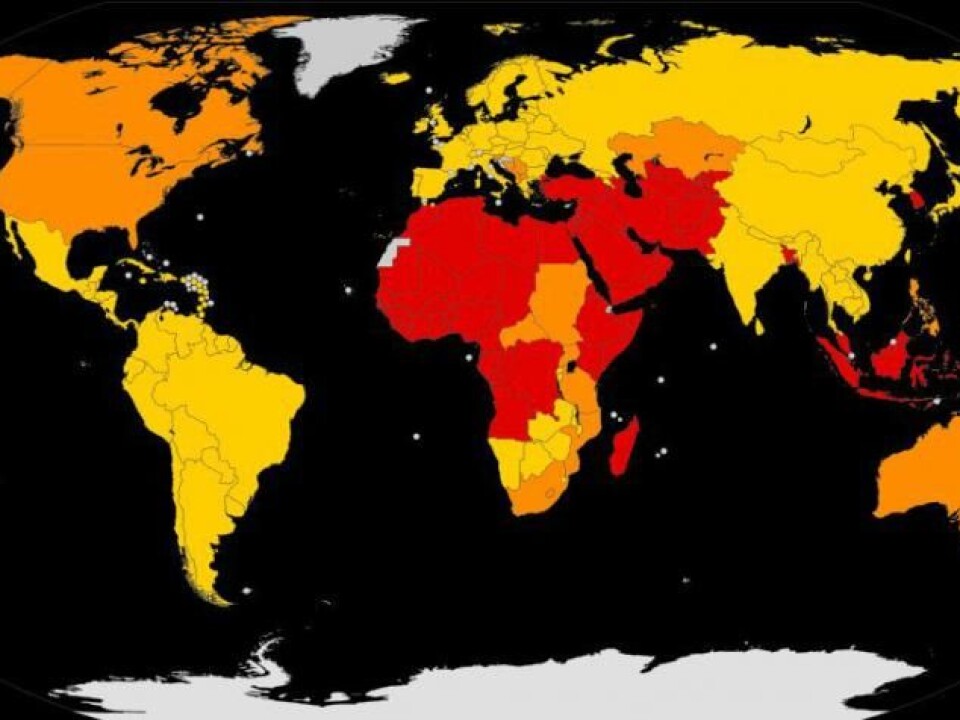
Male circumcision greatly increases risk of urinary tract problems
Circumcised boys are 16-26 times more likely to develop urinary tract problems, shows new research.
Circumcision, whereby the foreskin is removed from the penis, can cause the urethral opening to narrow, making it difficult to urinate.
The condition is called meatal stenosis and the risk of developing it is 16-26 times higher in circumcised than intact boys under the age of ten.
These are the conclusions of a new study based on data from the National Patient Register, the Central Population Register, and the National Health Service Register in Denmark between 1977 and 2013.
The results are published in the journal The Surgeon.
Urinary problems that require surgery

Meatal stenosis can occur several years after circumcision, and may lead to infection if left untreated. The only solution is a minor operation under general anaesthesia.
“This is the first population-based study to systematically follow circumcised and intact boys for meatal stenosis and other urethral strictures over many years. Our study challenges the dogma that circumcision rarely has negative consequences,” says lead-author Dr Morten Frisch, adjunct professor of sexual health epidemiology at Aalborg University and a consultant and senior investigator at Statens Serum Institut in Copenhagen, Denmark.
“One cannot say that this is something that causes trouble only occasionally. We must assume, based on rigorous clinical studies in the US, Iran, and other countries, that somewhere between 5 and 20 per cent of circumcised boys will eventually develop a pathological narrowing of the urinary opening as a late consequence of their circumcision,” says Frisch, who conducted the study along with statistician Jacob Simonsen, also from Statens Serum Institut.
Hundreds of Danish boys and men may develop meatal stenosis each year
In 2013, the Danish National Board of Health estimated that between 1,000 and 2,000 boys are ritually circumcised in Denmark each year.
If one combines these estimates with the percentages mentioned by Frisch, somewhere between 50 and 400 Danish boys and men will develop a narrowing of their urinary opening each year.
Great study--but where are the children?
Frisch is an active participant in the debate over ritual circumcision of boys, something which he declares openly in the new article. He describes himself as being “generally sceptical” of any practices involving genital surgery on healthy children--a standpoint rooted in medical ethics, he says.
The fact that Frisch is open about his views on the ethics of circumcision is described as commendable by Dr Yazan F. Rawashdeh, a physician at the Section of Paediatric Urology at Aarhus University Hospital, Denmark.
Rawashdeh describes the study as detailed and well-executed.
“It’s generally a nice, well-written study, and you can see that it’s written by an epidemiologist who knows how to conduct studies based on register data. It shows a link at the population level, which doctors already know and can confirm from their everyday clinical practice,” he says.
“The weakness of register-based studies is that you can sometimes find correlations without causality,” says Rawashdeh, who adds that given such a highly increased risk of meatal stenosis, he would expect to see more than the three cases a year that he typically observes.
Few boys undergo urinary tract operations
Professor Jørgen Thorup from the University of Copenhagen, Denmark, agrees.
Thorup is responsible for paediatric urology at Rigshospitalet, which, together with the University Hospital in Skejby, Denmark, are the only Danish hospital departments taking care of children with meatal stenosis.
Physicians are aware of the relationship between circumcision and narrowing of the urinary opening, says Thorup, but according to hospital records, meatal stenosis only affects 0.5 per cent of circumcised boys, whereas around 0.17 per cent of intact boys get the problem due to a skin disease known as BXO.
That is a noticeably higher proportion of circumcised boys, but not in the order of 26 times more.
Frisch: The risk is probably even higher
The study methodology is robust as it is based on individual data from all participants, says Frisch.
The scientists assessed who had been circumcised in the public health system and combined this information with Danish hospital records of who was later treated for meatal stenosis.
This allowed them to compare the risk of developing the condition among circumcised and intact boys.
“An unknown, but probably significant, number of boys will have been circumcised abroad, or a foreign circumciser may have come to Denmark to perform the operation. These boys will mistakenly be assigned to the ‘intact’ category. Such misclassification most likely leads to underestimation of the true relative risk, so the risk among circumcised boys is likely even higher than suggested by our results,” says Frisch.
Risk assessment fits with studies in humans
Frisch adds that it is not only children, but also adults, who develop meatal stenosis.
Clinical studies in the US, UK, Iran, and Bangladesh, which examined all the participating boys’ urinary opening several years after the circumcision, have discovered that between 5 and 20 per cent developed the condition.
“Our estimates of the relative risk are indeed very high, but they are in excellent agreement with more than 100 years of clinical knowledge--especially in countries where circumcised boys and men account for a much higher proportion of the male population than in Denmark,” he says.
According to the American Academy of Pediatrics (AAP), meatal stenosis is a problem almost exclusively seen in circumcised boys, and therefore the relative risk will naturally be very high, says Frisch.
Higher estimates in the UK, US, and Israel
The new study estimates that circumcision is responsible for at least 18 per cent of all operations for meatal stenosis and other urethral strictures in Danish boys under the age of ten years.
Extending these calculations to countries where circumcision is much more prevalent, Frisch and Simonsen estimate that circumcision is responsible for at least 42 per cent of all operations for meatal stenosis and other urethral strictures in less than ten-year-old UK boys. In the US, the proportion rises to at least 78 per cent, and, in Israel, to at least 81 per cent.
Frisch and Simonsen emphasize that these minimum percentages are calculated based on very conservative estimates of the relative risk. The true proportions of paediatric cases of meatal stenosis and other urethral strictures that are attributable to circumcision in the countries mentioned are most likely considerably larger, they say.
“Our findings, coupled with clinical evidence that between 5 and 20 per cent of circumcised boys will eventually develop meatus stenosis, document a need for a thorough assessment of the extent of urinary tract problems and other complications after non-therapeutic circumcision of boys,” write the researchers in the article published in The Surgeon.
Frisch hopes that other researchers around the world will now take up the challenge and repeat the study to learn if the Danish study findings can be confirmed.
“Circumcision of healthy boys is probably the world's most frequent surgical procedure but, strangely, the long-term complications beyond the first year after the surgery have never been thoroughly investigated,” says Frisch.
“In the US alone, the cost of operations for meatal stenosis and other urethral stricture diseases amounts to several hundred million dollars a year. We need more science in this area,” he says.
-------------------
Read the Danish version of this story on Videnskab.dk
Translated by: Catherine Jex
Scientific links
- Cultural background, non-therapeutic circumcision and the risk of meatal stenosis and other urethral stricture disease: Two nationwide register-based cohort studies in Denmark 1977-2013; The Surgeon; DOI: 10.1016/j.surge.2016.11.002
- Circumcision of male infants and children as a public health measure in developed countries: A critical assessment of recent evidence; Global Public Health; DOI: 10.1080/17441692.2016.1184292
- Incidence of meatal stenosis following neonatal circumcision in a primary care setting; Clin Pediatr (Phila). 2006 Jan-Feb;45(1):49-54 (PubMed)
- Incidence of asymptomatic meatal stenosis in children following neonatal circumcision; Journal of Pediatric Urology; DOI: 10.1016/j.jpurol.2010.08.005
- Lubrication of circumcision site for prevention of meatal stenosis in children younger than 2 years old; Urol J. 2008 Fall;5(4):233-6.
- Clinical presentation and pathophysiology of meatal stenosis following circumcision; BJUI; DOI: 10.1111/j.1464-410X.1995.tb07242.x








